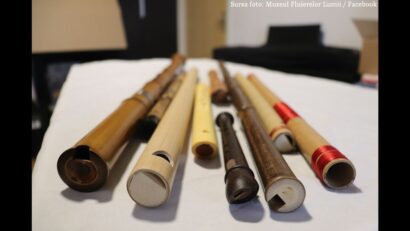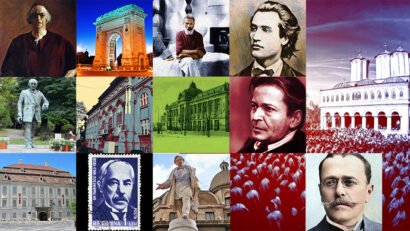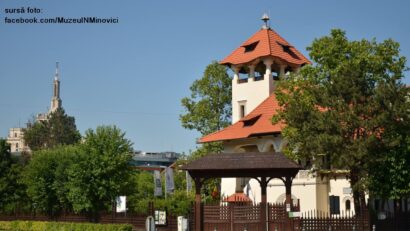The Constanta Casino
We invite you to discover the story of the Casino in Constanta

Iuliana Sima Anghel, 01.03.2025, 13:00
We invite you to discover the story of the Casino in Constanta, the emblem of the largest Romanian port city on the Black Sea, founded by Greek colonists in antiquity under the name of Tomis. The name of this settlement is linked to the legend of the Argonauts, but especially the exile of the Latin poet Publius Ovidius Naso. The symbol of the city today is, indisputably, the casino, built in the Art Nouveau style, and inaugurated in 1910, on August 15, when Romania celebrates Navy Day.
Since 1879, Constanta has been seen not only as a port, but also as a seaside resort. In 1880, the first dance hall was created – the Guarracino Hall, seriously damaged in 1891 by a strong storm. The following year, the city hall built a new building, which operated until the spring of 1910. The story of the casino itself begins, however, in 1903, when mayor Cristea Georgescu signed a contract with architect Daniel Renard, who would design the casino’s plans in the Art Nouveau style, explains Delia Roxana Cornea, interim director of the Constanța Museum of National History and Archaeology.
“On August 15, 1910, this beautiful Carol I Communal Casino was inaugurated, the title with which it appeared in the press of the time, which treated this subject very well. We even have the menu served at the inauguration, with wild fowl eggs, fois gras, Drăgășani wine and other such products. The casino had a very good evolution until around the First World War. In 1916, Dobrogea fell under German-Bulgarian occupation and many of the buildings in Constanta were occupied, and upon departure were looted. This was also the case with the Casino, which had been transformed into a military hospital and, although it had the Red Cross on the roof, it seems that a bomb still fell on it, destroying part of the interior staircase. Rebuilt in the 1920s, the Casino regained its splendor in the interwar period when August 15 and the nautical celebrations were very intensely experienced by both locals and visitors. Other events also took place. Almost all charity balls took place at the Communal Casino, we have confirmations of the presence of various members of the royal family. The tradition was perpetuated on August 15 among Romanians, it has been celebrated with the same pomp for decades to the present day.”
The Casino’s peak moment was reached, therefore, in the 1920s and 1930s, when Constanța became a very prosperous city, says historian and writer Cristian Cealera, a guide at the city’s National Museum of History and Archaeology.
“Let’s not forget that there were 19 minorities in Dobrogea, but following a census in Constanța, which had a population of over 56,000 inhabitants in the 1920s, no less than 33 nationalities were registered. It is less known that, at that time, there were transatlantic flights from Constanța to New York, and that in some gardens, even on the terrace of the Casino, bands from New Orleans would come and play jazz. It is a history with salt and pepper, because we are talking about sopranos and tenors from La Scala in Milan, about groups of actors who fought to get a contract at the Casino in the summer. World boxing champions met at the Casino or on the improvised arena in front of the building. People loved coming here. Let’s not forget the Navy Days, August 15 was the most important event every summer. Of course, gambling, more prominent in the 1930s, brought both good and less good things. The whole city prospered, restaurants and hotels recorded very good incomes, but at the same time gambling claimed victims because, while the rich left Monte Carlo to come to Constanța because it was even cheaper, the less fortunate, the petty officials, the locals, did not know how to manage this problem, and hence many sad stories. We have all kinds of events recorded in the press of the time: suicides, scandals like “the girlfriend spent the boyfriend’s money who the next day eagerly followed her to shoot her on the Casino promenade.”
After 1940, the building fell under a shadow, because World War II had already begun. It was occupied by German troops and then by Soviet troops, after October 1944. The casino had a sad story during the communist period, at least in the beginning. Although it was left in disrepair for a long time, the question of its reuse was raised again, and the renovation works in the 1950s used a workforce based not only on civilians, but also on political prisoners from the prisons and camps on the Danube-Black Sea Canal. A sad reality, also demonstrated by two notes written by the team led by architects Constantin Joja and Ion Cristodulo, political prisoners at the time. The first note was discovered in the walls of the casino during the restoration works that began in early 2020, and the second in 2023. From the 1980s until after 1990, the Casino in Constanța functioned as a restaurant-terrace. After 2000, it was closed to the public until sufficient funds and solutions for restoration were found. The building will host exhibition spaces dedicated to the history of the Casino and a multifunctional cultural center.





























